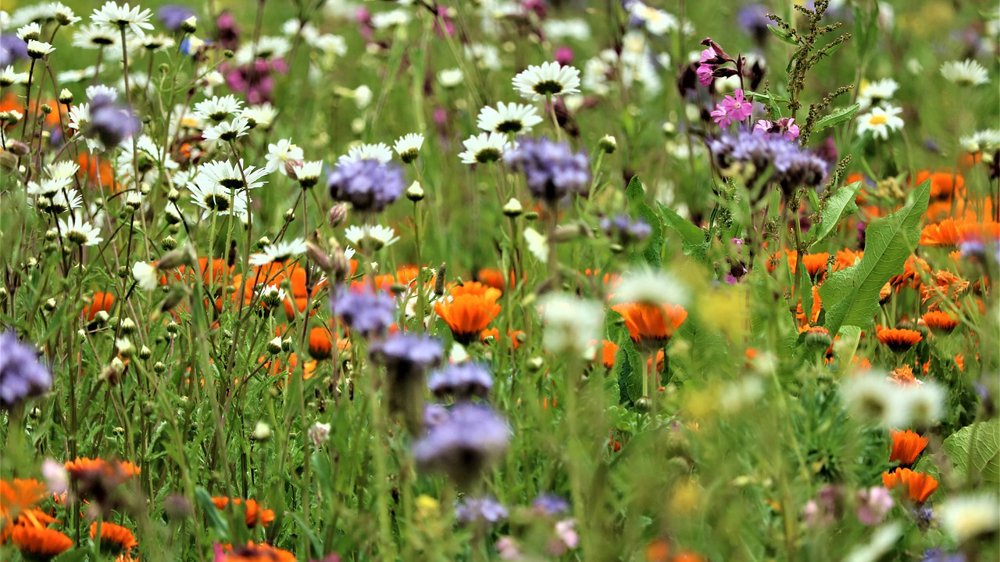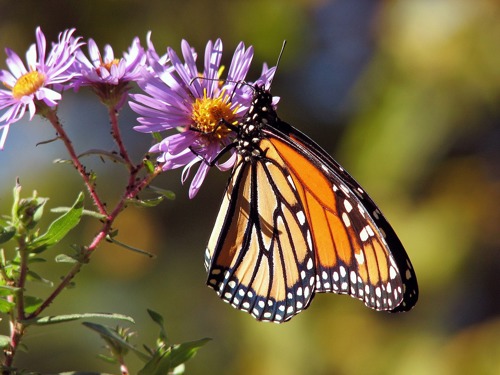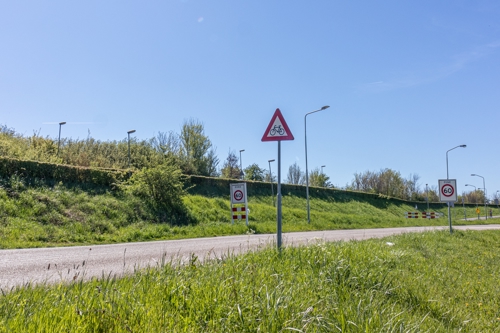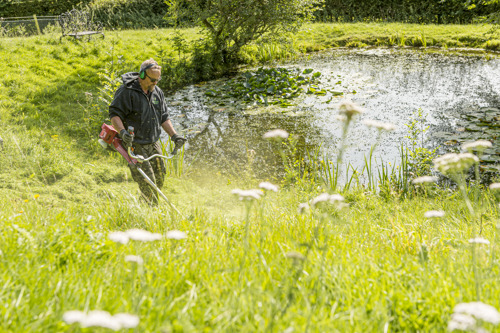How does rewilding impact landscaping professionals?
6 Sept 2023 Landscaping & Turfcare
Though it may sound like it, rewilding isn’t just about taking some time off and letting grass grow as wild as it pleases. It actually has quite a bit of science behind it, and is a process that landscapers are key in supporting.
You may not have heard of it until recently, but rewilding is not a new concept. It was actually introduced in the conservation world in the 1980s and encouraged in Europe with a vision to protect large areas of wilderness, slow climate change and protect keystone species through natural processes.
Why is rewilding becoming so popular?
Since the 1980s, the concept of letting nature thrive without human intervention has moved from the wilderness and onto our doorsteps.
The global pandemic saw a huge shift in our relationship with the natural world, with the lack of regular landscaping seeing the number of rewilding projects boom – or rather bloom.
What might have been an accident at the time has since turned into a continent-wide initiative of ecological restoration encouraged by the European Green Deal and EU Biodiversity Strategy.
For professional landscapers, this could mean working with clients – from private businesses and homeowners to councils – to support their rewilding projects and initiatives of ecosystem restoration, and ultimately managing these new areas of wilderness in the community.
What are the benefits of rewilding?
If landscapers are to let the landscapes they’ve worked hard to carefully maintain run wild, there must be a good reason for it, right? There is.
Rewilding focuses on letting the natural world reclaim parts of the landscape, which can have huge ecological and environmental benefits to the surrounding areas as well as to the greater climate. We explore some of those benefits here:
More biodiversity

Increasing biodiversity among wildlife, plants and insects in areas that have been impacted by human habitation is one of the main driving factors behind rewilding.
An increase in wildflower and native plants helps support the survival and movement of essential pollinator species such as butterflies, bees, hummingbirds and moths as they provide a valuable food source of nectar and pollen.
The benefit of increasing the number of pollinator-friendly spaces extends further than just the survival of these essential species. As they travel between rewilded areas they carry with them the seeds that allow for cross-pollination between plant varieties. These ecological processes promote a higher genetic diversity in plants and contribute to the overall health and functioning of the ecosystems in which they exist. They create an environment that is ideal for efficient nutrient cycling and better control of soil erosion and water filtration in the soil.
The growth of wildflowers as part of rewilding initiatives can also reduce the need for pesticides on greens and verges, as landscapers can instead rely on a more natural means of control. Wildflowers attract insects that prey on harmful pests that can damage the growth of vital plants and grasses.
Reducing emissions
Rewilding projects aren't only for the countryside. In fact, the introduction of wild nature into more urban and residential spaces can have a positive impact on air quality.
Plants absorb carbon dioxide from the atmosphere, so increasing their numbers helps to counteract emissions. They store CO₂ as they undergo photosynthesis, and wildflowers are better at this process than most. Extensive root systems mean they can store carbon in the soil for a number of years so that it's in the ground rather than in the air.
Local communities
Flower rich spaces, especially on areas such as verges around roadsides and in the community are becoming increasingly popular with local residents, as they encourage wildlife into the heart of built-up environments. Rewilding can bridge the gap between modern society and nature, providing greater access to green spaces that have been known to improve human health and wellbeing.
On a larger scale, rewilding large areas can have socio-economic benefits too as it can encourage eco-tourism. As more people venture to the area to visit resurgent wildlife, they will in turn spend money at local businesses during their stay.
How can landscapers manage rewilded areas?
Don’t worry, rewilding doesn’t mark the end of landscape maintenance as we know it. It just means that in areas that are home to rewilding projects, landscape management might look a bit different.
Framing verges and other wildflower areas isn't the only form of maintenance that needs to be done when it comes to managing wild spaces. In reality, letting grass grow wild can actually make more work for landscapers.
Though some areas of the countryside may be able to rely on the natural grazing of livestock and wildlife to keep wild spaces in check, for the vast majority of rewilded spaces across Europe, the work of a professional landscaper is much needed.
Rewilding on roadside verges

Rewilding isn't always for the countryside – a popular space for rewilding is roadside verges and roundabouts.
Allowing the growth of wildflowers in these areas creates important wildlife corridors by creating a strip of land between roadsides and fences. These strips of nature not only break up more urban landscapes, they provide essential habitats for important plants, flowers and invertebrates, while also helping with pollution, all benefits previously discussed.
When it comes to roadsides, however, road user safety is of the utmost importance, which is where professional landscapers will need to step in to keep these areas managed.
Verges even as part of a rewilding project should be kept short so that motorists and cyclists can continue to see clearly across both bends and straights, and should allow pedestrians to be able to safely walk along roadsides.
The answer to this safety risk? Framing verges.
Framing verges
Framing a verge is an important way in which landscapers can manage these rewilded areas. By cutting the grass borders of a rewilded area short, they can maintain a clean appearance even when nature is left to grow wild within.
It involves landscapers cutting narrow strips bordering wildflower-rich verges. The shorter grass at the front helps driver visibility on the road and at junctions, while the different heights in vegetation allow for plant diversity as some plant species will naturally favour low growth.
Most verges require a frame that is approximately one mower width, or at most 1.4m around its borders to frame the longer grass and wildflowers behind it. Landscapers should anticipate regular maintenance on these verges to occur every two to four weeks to keep roadsides tidy and prevent a surplus of growth.
Mowing wild spaces through the seasons
A wildflower meadow might need less maintenance than a manicured lawn, but it is certainly not the time to pack the mower away. A considered cutting schedule that accounts for seasonal changes will let the land reap the benefits of rewilding while still looking managed.
Spring
Spring is when the vast majority of plant growth will occur and you'll see wildflowers start to bloom. It is also when the grass in wildflower areas might start to crowd out the other plant species. Cutting this grass back will leave more room for the flowers themselves to do their job, so landscapers should consider mowing the grass back to a height of approximately 7.5cm. This will keep the flower-to-grass ratio in verges and meadows balanced while still looking plentiful.
Summer
Wildflower areas will benefit from a main cut, also known as the 'hay cut' to remove the bulk of material at the end of the summer, mimicking the cutting patterns of the old hay meadows to keep the space under control. Leaving mowing until later in the season will allow grass to grow in length and provide shelter for garden wildlife against the sun, while a large cut at the end of the season will provide a great reset in time for autumn. Just remember to remove the clippings afterwards!
Wildflowers thrive in poor-quality soil, another reason why rewilding might be suitable in areas where other grasses might struggle to grow. Removing clippings and other mowing debris will stop nutrients from entering back into the soil and boosting its fertility and causing a surplus of growth that can be much harder to stay on top of.
Autumn
That being said, all is not lost if the rewilded spaces you are managing experience a particularly fruitful year of growth. It just means that come autumn another round of mowing might be in order to remove the surplus of growth and keep grasses at bay.
Winter
Winter is as hard for rewilded areas as it is for any other landscaped space. Landscapers should focus on ensuring the land is kept primed and ready for regrowth in the spring. It can also be a time to rest these wilder spaces and tidy them up by keeping grass mowed down to ankle height, ensuring clippings are removed once more and composted to minimise the soil's fertility.
What machines are best for the job?
For smaller areas of rewilding, a brushcutter is the ideal landscaping tool to keep nature under control. Powered by Kawasaki brushcutters are renowned for their exceptional power and durability, with a robust full-cover casing, fuel tank protector and a heavy-duty clutch for most engine models, they are ideal for the most demanding levels of use when maintaining rewilded areas.

For tackling larger areas of growth, a ride-on mower is the logical solution for any professional landscaper as it will allow them to cover a lot of ground easily. Maintaining meadows and operating in the thick of rewilded areas can be tough work, meaning landscapers need a machine they can rely on no matter its working conditions.
Kawasaki powered ride-on mowers are not only powerful enough to cut effortlessly through long, tough grass, they are also engineered with features that make them ultra-reliable in exactly these environments: robust air filtration systems, grass debris screens and high performance lubrication mean you can be confident in taking on this new style of mowing.
Incorporate rewilding into your maintenance schedule
When it comes to rewilding, it’s clear that there’s no one-size-fits-all approach. Every client interested in this growing trend will likely take a different approach based on the benefits they want for their green spaces, whether that be increased biodiversity in their gardens, contributing towards their eco-mission for cleaner air, or simply a new wilder look for their grounds.
Keeping on top of the trend, even as it might continue to change, will allow you as their landscape professional to offer the best solutions to create a small section of wilderness on their doorstep. Visit our Powered by Kawasaki page to explore the equipment that can help you carry out your rewilding work.
You may be interested in
-
The most iconic green spaces in Europe

-
When should you scarify a lawn and how to revive it afterwards

-
What are the greenest countries in Europe?

-
How to weatherproof a lawn and protect it from flood, frost and drought

-
Landscaping trends for 2024

-
Have you fallen for any of these landscape maintenance myths?







